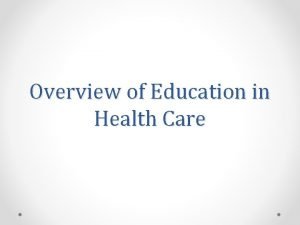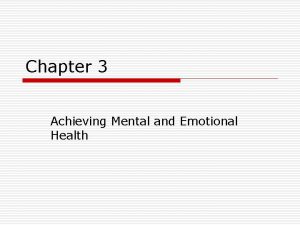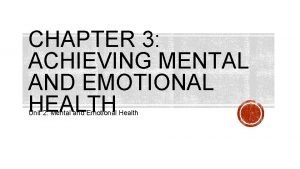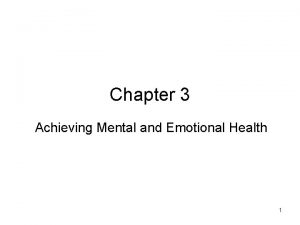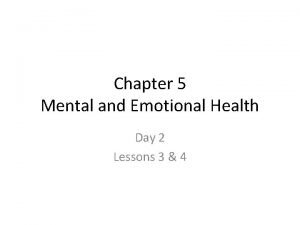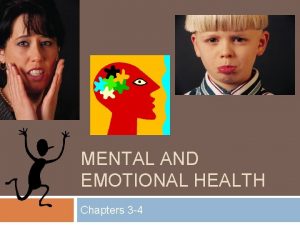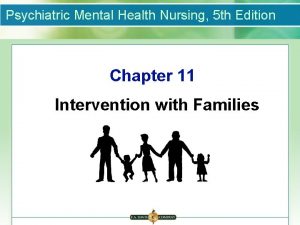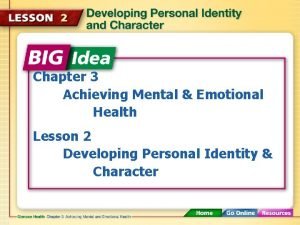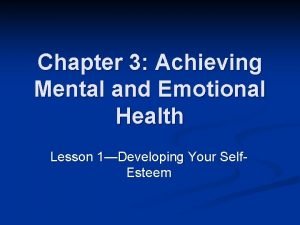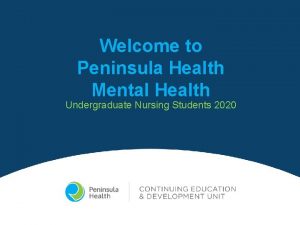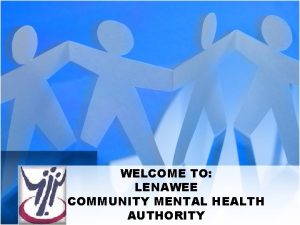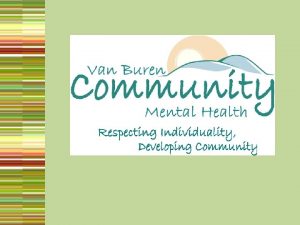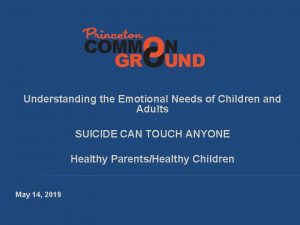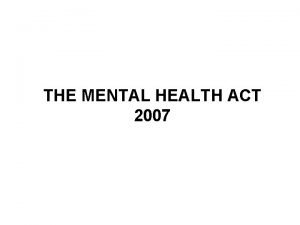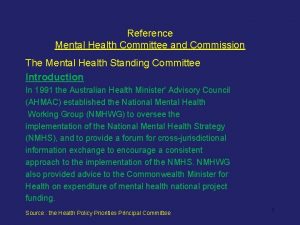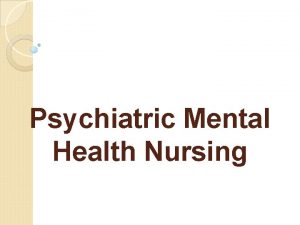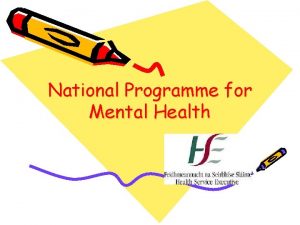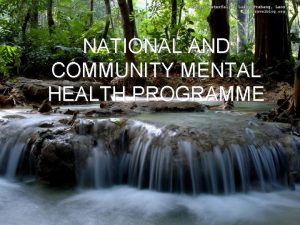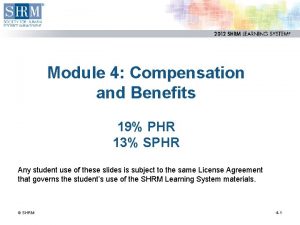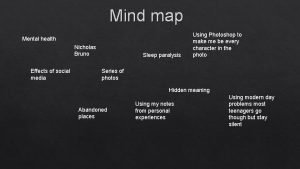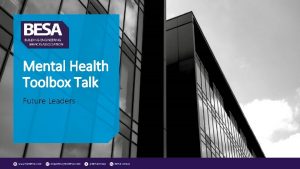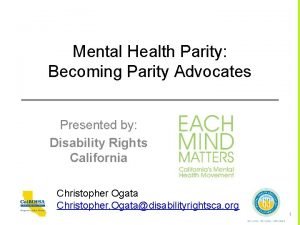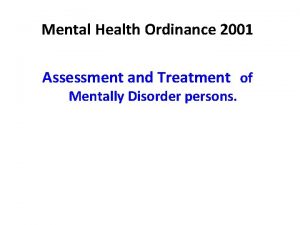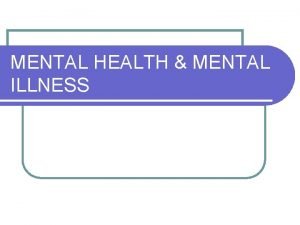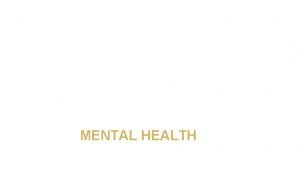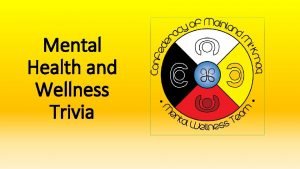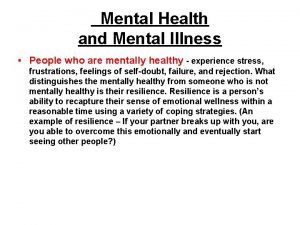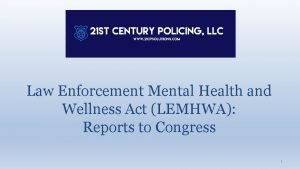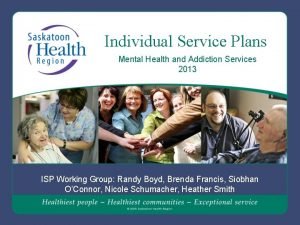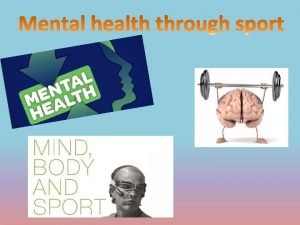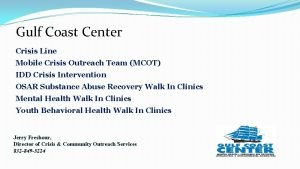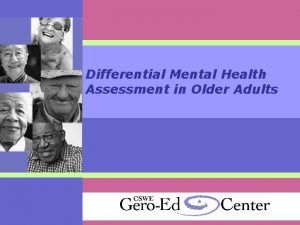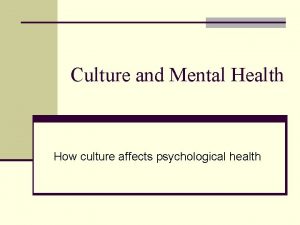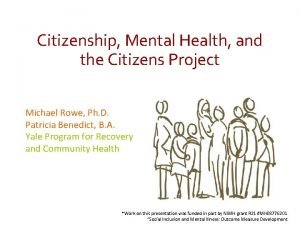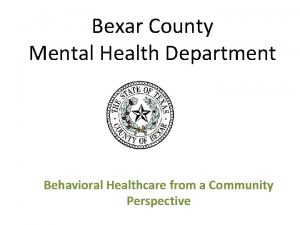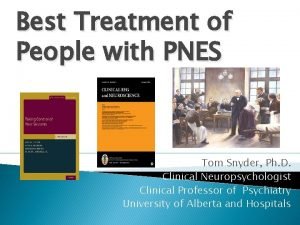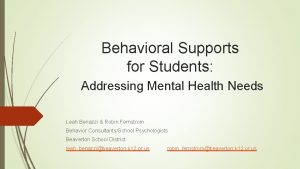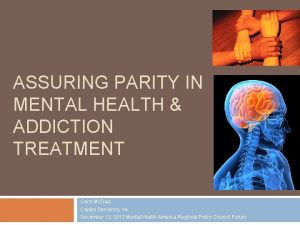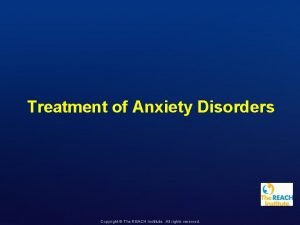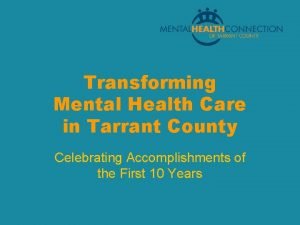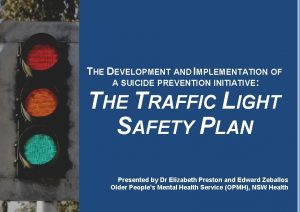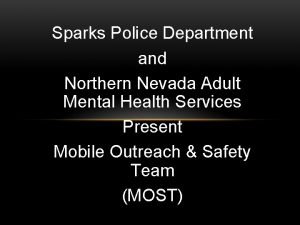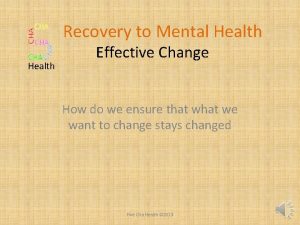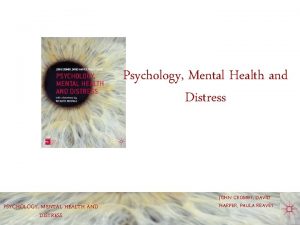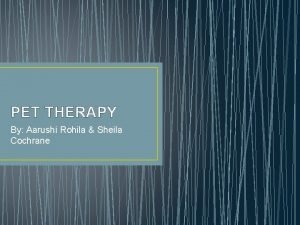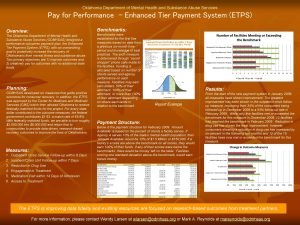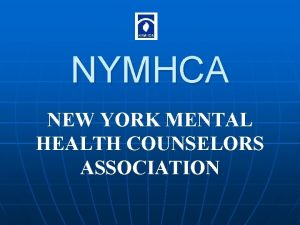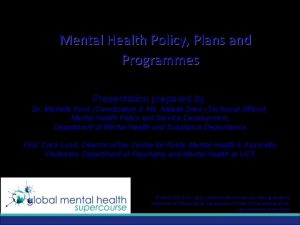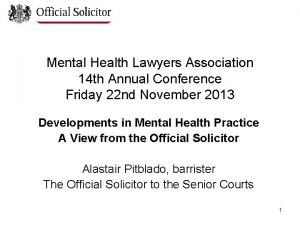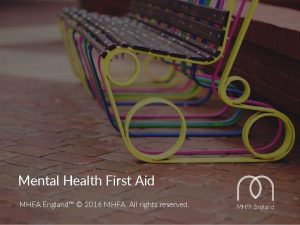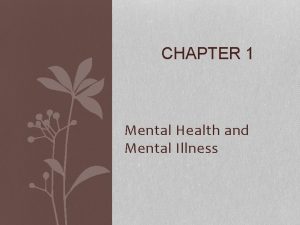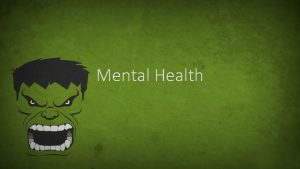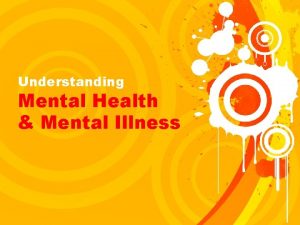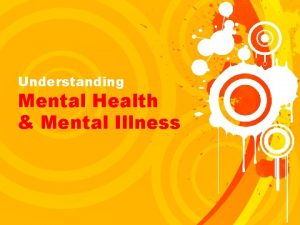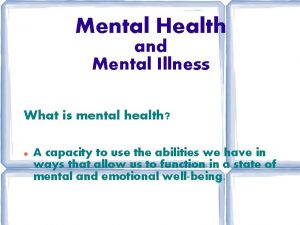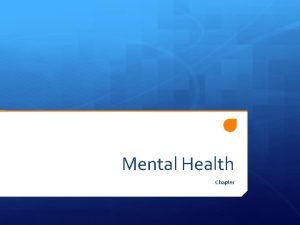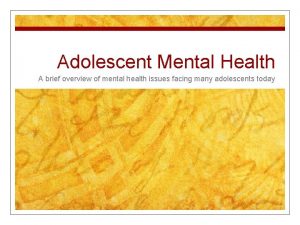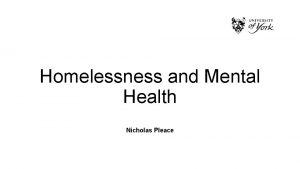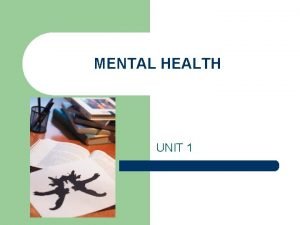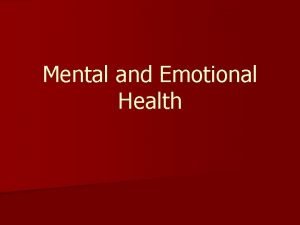CHAPTER 23 Mental Health Mental Health Overview Mental























































































- Slides: 87

CHAPTER 23 Mental Health

Mental Health Overview • Mental health – Relative state of mind in which the person who is healthy is able to cope with and adjust to the recurrent stresses of everyday living in an acceptable way 2

Mental Health Overview • Mental disorders – Disturbances of emotional stability, as manifested in maladaptive behavior and impaired functioning • Defense mechanisms – Body’s unconscious reaction to protect itself from conflicts or anxieties 3

Mental Health Overview • Psychology – Study of behavior and processes of the mind as it relates to the individual’s social and physical environment • Psychologist – Professional who specializes in the study of the structure and function of the brain and related mental processes • Not a medical doctor • MA or Ph. D degree 4

Mental Health Overview • Psychiatry – Branch of medicine that deals with the causes, treatment, and prevention of mental, emotional, and behavioral disorders • Psychiatrist – Medical doctor who specializes in diagnosing, preventing, and treating mental disorders • Many subspecialties 5

Defense Mechanisms • Compensation – Effort to overcome, or make up for, real or imagined inadequacies • Denial – Refusal to admit or acknowledge the reality of something, thus avoiding emotional conflict or anxiety 6

Defense Mechanisms • Displacement – Process of transferring a feeling or emotion from the original idea or object to a substitute idea or object • Introjection – Individual unconsciously identifies with another person or with some object • Individual assumes the supposed feelings and/or characteristics of the other personality or object 7

Defense Mechanisms • Projection – Act of transferring one’s own unacceptable thoughts or feelings on to someone else • Rationalization – Attempting to make excuses or invent logical reasons to justify unacceptable feelings or behaviors, most commonly used defense mechanism 8

Defense Mechanisms • Regression – Response to stress in which the individual reverts to an earlier level of development and comfort measures associated with that level of functioning • Repression – Involuntary blocking of unpleasant feelings and experiences from one’s conscious mind 9

Defense Mechanisms • Sublimation – Rechanneling or redirecting one’s unacceptable impulses and drives into constructive activities • Suppression – Voluntary blocking of unpleasant feelings and experiences from one’s mind 10

Classification of Mental Disorders • DSM-IV-TR Multiaxial Classification System – Sixteen major diagnostic classifications – Each classification includes several disorders – Disorders are grouped based on shared features – Includes five axes for classification 11

Classification of Mental Disorders • Axis I – Clinical Disorders – Other conditions that may be a focus of clinical attention • Axis II – Personality Disorders – Mental retardation 12

Classification of Mental Disorders • Axis III – General Medical Conditions • Axis IV – Psychosocial and Environmental Problems • Axis V – Global Assessment of Functioning 13

SPECIFIC MENTAL DISORDERS Mental Health

Cognitive Disorders • Cognitive disorders – Those that affect the individual’s ability to perceive, think, reason, and remember – Organic mental disorders – Includes: • Amnesia disorders • Delirium • Dementia 15

Amnesia Disorders • Pronounced – (am-NEE-zee-ah) • Defined – Characterized by short-term and long-term memory deficits • Have normal attention but are unable to learn new information • Unable to recall previously learned information 16

Delirium • Pronounced – (dee-LEER-ee-um) • Defined – Frenzied excitement that occurs rapidly and is characterized by difficulty maintaining and shifting attention • Individual is easily distracted and must be constantly reminded to focus attention 17

Dementia • Pronounced – (dee-MEN-she-ah) • Defined – Progressive, organic mental disorder characterized by chronic personality disintegration, confusion, disorientation, stupor, deterioration of intellectual capacity and function, and impairment of control of memory, judgment, and impulses 18

Substance-Related Disorders • Associated with the use of drugs – Characteristics: • Psychological dependence on the substance • Daily use • Frequent intoxication by ingestion of the substance • Inability to control use of substance • Physical dependence involves serious withdrawal symptoms 19

Substance-Related Disorders • Drugs of substance-related disorders – Central nervous system depressants • Slow activity of the CNS, causing impaired motor activity, judgment, and concentration – Central nervous system stimulants • Increased activity of CNS, causing elevated blood pressure, heightened behavioral activity and alertness – Hallucinogens • Create perceptual distortions of the mind 20

Schizophrenia • Pronounced – (skiz-oh-FREN-ee-ah) • Defined – Any of a large group of psychotic disorders characterized by gross distortion of reality, disturbances of language and communication, withdrawal from social interaction, and disorganization and fragmentation of thought, perception, and emotional reaction 21

Schizophrenia • Characteristic symptoms – Hallucinations • Person perceives something that does not exist in the external environment – Delusions • Person firmly holds to a persistent abnormal belief or perception despite evidence to the contrary 22

Schizophrenia • Characteristic symptoms – Disorganized speech • Person may move rapidly from one topic to another, making little sense – Disorganized or catatonic behavior • Person may alternate between agitation and nonpurposeful or random body movements to little or no behavioral response to the environment – Flattened affect • Individual shows little or no emotional response to the environment 23

Paranoid Schizophrenia • Pronounced – (PAIR-ah-noyd skiz-oh-FREN-ee-ah) • Defined – Condition characterized by the individual being overly suspicious of others and having hallucinations and delusions 24

Mood Disorders • Group of psychiatric disorders characterized by disturbances in physical, emotional, and behavioral response patterns • Extreme elation and agitation to extreme depression with suicidal potential – Includes: • Bipolar disorders • Cyclothymic disorder • Major depressive disorder 25

Bipolar Disorders (Manic-Depressive) • Pronounced – (by-POHL-ar dis-OR-der) • Defined – Psychological disorder characterized by episodes of mania, depression, alternating between the two, or a mixture of the two moods simultaneously 26

Bipolar Disorders (Manic-Depressive) • Characteristics of mania – Extreme excitement, hyperactivity – Agitation, overly talkative – Flight of ideas, fleeting attention – Sometimes violent, destructive, and selfdestructive behavior – May have decreased need for sleep and seemingly limitless energy 27

Bipolar Disorders (Manic-Depressive) • Characteristics of depression – Symptoms are inappropriate and out of proportion with reality – Exaggerated feelings of sadness – Discouragement – Hopelessness 28

Anxiety Disorders • Individual feels increased tension, apprehension, a painfully increased sense of helplessness, a feeling of uncertainty, fear, jitteriness, and worry – Includes: • • • Generalized anxiety disorder Panic disorder Phobic disorder Obsessive-compulsive disorder Posttraumatic stress disorder 29

Anxiety Disorders • Observable signs of anxiety – Includes but not limited to: • • Restlessness Poor eye contact Glancing about Facial tension Dilated pupils Increase perspiration Constant focus on self 30

Generalized Anxiety Disorder • Pronounced – (generalized ang-ZY-eh-tee dis-OR-der) • Defined – Disorder characterized by chronic, unrealistic, and excessive anxiety and worry • Symptoms have usually existed for at least six months or more • Symptoms have no relation to any specific cause 31

Panic Disorder • Pronounced – (PAN-ik dis-OR-der) • Defined – Characterized by recurrent panic attacks that come on unexpectedly, followed by at least one month of persistent concern about having another panic attack 32

Panic Disorder • Characteristics – Intense apprehension, fear, or terror, often associated with feelings of impending doom – Person may experience: • • • Dyspnea Dizziness Sweating Trembling Chest pain or palpitations of the heart 33

Phobic Disorder • Pronounced – (FOH-bik dis-OR-der) • Defined – Anxiety disorder characterized by an obsession, irrational, and intense fear of a specific object, of an activity, or of a physical situation – Phobia disorder 34

Phobic Disorder • Classifications of phobias – Acrophobia • Fear of high places that results in extreme anxiety – Aerophobia • Morbid fear of fresh air or drafts – Agoraphobia • Fear of being in an open, crowded, or public place, such as a field, congested street, or busy department store, where escape may be difficult 35

Phobic Disorder • Classifications of phobias – Arachnophobia • Fear of spiders – Claustrophobia • Fear of closed spaces – Nyctophobia • Obsessive, irrational fear of darkness – Zoophobia • Persistent, irrational fear of animals, particularly dogs, snakes, insects, and mice 36

Obsessive-Compulsive Disorder • Pronounced – (ob-SESS-iv kom-PUHL-siv dis-OR-der) • Defined – Disorder characterized by recurrent obsessions or compulsions that are severe enough to be time consuming, (they take more than one hour a day), or to cause obvious distress or a notable handicap 37

Obsessive-Compulsive Disorder • Obsessions – Repeated, persistent thoughts or impulses that are irrational and with which the mind is continually and involuntarily preoccupied • Compulsions – Irresistible, repetitive, irrational impulses to perform an act • Behavior patterns that are intended to reduce anxiety, not to provide pleasure or gratification 38

Posttraumatic Stress Disorder • Pronounced – (post-trah-MAT-ik Stress dis-OR-der) • Defined – Individual experiences characteristic symptoms following exposure to an extremely traumatic event • Individual reacts with horror, extreme fright, or helplessness to the event 39

Somatoform, Sleep, and Factitious Disorders • Somatoform disorders – Any group of neurotic disorders characterized by symptoms suggesting physical illness or disease – No demonstrable organic causes of physiologic dysfunctions 40

Somatoform, Sleep, and Factitious Disorders • Sleep disorders – May be related to stress, anxiety, or physiological problems • Factitious disorders – Characterized by physical or psychological symptoms that are intentionally produced or feigned to assume the sick role 41

Somatoform, Sleep, and Factitious Disorders • Malingering – Willful and deliberate faking of symptoms of a disease or injury to gain some consciouslydesired end – Malingering • Of the conscious mind • Results in secondary gain – Somatoform disorder • Unconscious • Results in reduction of anxiety 42

Somatoform, Sleep, and Factitious Disorders • Examples: – Conversion disorder – Hypochondriasis – Munchausen syndrome (by proxy) – Narcolepsy – Pain disorder 43

Conversion Disorder • Pronounced – (kon-VER-zhun dis-OR-der) • Defined – Disorder in which the individual represses anxiety experienced by emotional conflicts by converting the anxious feelings into physical symptoms that have no organic basis, but are perceived to be real by the individual 44

Hypochondriasis • Pronounced – (high-poh-kon-DRY-ah-sis) • Defined – Chronic, abnormal concern about the health of the body characterized by: • Extreme anxiety, depression • Unrealistic interpretation of real or imagined physical symptoms as indications of a serious illness or disease despite rational medical evidence that no disorder is present 45

Munchausen Syndrome (By Proxy) • Pronounced – (mun-CHOW-zen SIN-drom by PROCKSsee) • Defined – Somewhat rare form of child abuse in which a parent of a child falsifies an illness in a child by fabricating or creating the symptoms, and then seeks frequent medical attention for the child 46

Narcolepsy • Pronounced – (NAR-coh-lep-see) • Defined – Sleep disorder that is characterized by repeated, uncontrollable desire to sleep, often several times a day • Attacks must occur daily over a period of at least three months to establish the diagnosis 47

Pain Disorder • Pronounced – (pain dis-OR-der) • Defined – Psychological disorder in which the patient experiences pain in the absence of physiologic findings 48

Dissociative Identity Disorders • Emotional conflicts that are so repressed into the subconscious mind that a separation or split in personality occurs – Results in an altered state of consciousness or a confusion identity – Includes: • Dissociative amnesia • Dissociative fugue • Dissociative identity disorder 49

Dissociative Amnesia (Formerly: Psychogenic Amnesia) • Pronounced – (diss-SOH-see-ah-tiv am-NEE-zee-ah) • Defined – The individual is unable to recall important personal information, usually of a traumatic or stressful nature • Loss of memory is more than simple forgetting 50

Dissociative Fugue (Formerly: Psychogenic Fugue) • Pronounced – (diss-SOH-see-ah-tiv FYOOG) • Defined – The individual separates from a past life and associations, wanders away for a period of time, and returns with no recollection of the disappearance 51

Dissociative Identity Disorder (Formerly Multiple Personality) • Pronounced – (diss-SOH-see-ah-tiv identity dis-OR-der) • Defined – Presence of two or more distinct personalities within one individual • At some point in time, each personality takes complete control of the person’s behavior 52

Sexual and Gender Identity Disorders • Sexual Dysfunctions – Disturbance in sexual desire and sexual response – Cause marked distress and interpersonal difficulty • Gender Identity Disorders – Strong and persistent cross-gender identification accompanied by persistent discomfort with one’s assigned sex • Paraphilias 53

Paraphilias • Paraphilias – Recurrent, intense sexual urges, fantasies, or behaviors that involve unusual objects, activities, or situations – Includes: • • • Exhibitionism Fetishism, transvestic Frotteurism Pedophilia Sexual sadism/sexual masochism 54

Exhibitionism • Pronounced – (egs-hih-BIH-shun-izm) • Defined – Sexual disorder involving exposure of one’s genitals to a stranger 55

Fetishism, Transvestic • Pronounced – (FEH-tish-izm, trans-VESS-tik) • Defined – Sexual disorder in which the focus of the fetish involves cross-dressing • Male usually keeps a collection of female clothing that he intermittently uses to cross-dress 56

Frotteurism • Pronounced – (FROH-chur-izm) • Defined – Sexual disorder in which the person gains sexual stimulation or excitement by rubbing against a non-consenting person • Sexual arousal is achieved through the act of rubbing and/or touching, which includes fondling 57

Pedophilia • Pronounced – (pee-doh-FILL-ee-ah) • Defined – Sexual disorder in which the individual is sexually aroused and engages in sexual activity with children (generally age 13 or younger) • Person is known as a pedophile 58

Sexual Sadism Sexual Masochism • Pronounced – (SEKS-yoo-al SAY-dizm) – (SEKS-yoo-al MASS-oh-kism) • Defined – Sexual disorder that involves the act (real, not simulated) of being humiliated, beaten, bound, or otherwise made to suffer, or the act of inflicting psychological or physical suffering on the victim 59

Sexual Sadism Sexual Masochism • Examples – Restraining by holding down or tying down – Slapping – Spanking – Blindfolding – Beating – Burning – Rape – Cutting and torturing 60

Eating Disorders • Characterized by severe disturbances in eating behavior – Individuals have a morbid fear of gaining weight – Includes: • Anorexia nervosa • Bulimia nervosa 61

Anorexia Nervosa • Pronounced – (an-oh-REK-see-ah ner-VOH-suh) • Defined – Disorder characterized by an emotional disturbance concerning body image, prolonged refusal to eat followed by extreme weight loss, amenorrhea, and a lingering, abnormal fear of becoming obese • Seen primarily in adolescent girls 62

Bulimia Nervosa • Pronounced – (boo-LIM-ee-ah ner-VOH-suh) • Defined – An uncontrollable craving for food, often resulting in eating binges, followed by vomiting to eliminate food from stomach • Individual may feel depressed, go through a period of self-deprivation, followed by another eating binge, and the cycle continues 63

Personality Disorders • Rigid, inflexible, and maladaptive patterns of behavior that impair a person’s ability to function well in society due to a limited ability to adapt – Includes: • • • Antisocial personality disorder Borderline personality disorder Narcissistic personality disorder Paranoid personality disorder Schizoid personality disorder 64

Antisocial Personality Disorder • Pronounced – (an-tih-SOH-shal per-son-AL-ih-tee dis-ORder) • Defined – Characterized by repetitive behavioral patterns that lack moral and ethical standards, keeping the individual in continuous conflict with society • Individual demonstrates socially irresponsible, guiltless behavior 65

Borderline Personality Disorder • Pronounced – (BOR-der-line per-son-AL-ih-tee dis-OR-der) • Defined – Extensive pattern of instability of interpersonal relationships, self-image, and marked impulsivity that begins by early adulthood and is present in a variety of contexts 66

Narcissistic Personality Disorder • Pronounced – (nar-sih-SISST-ik per-son-AL-ih-tee dis-ORder) • Defined – Abnormal interest in oneself, especially in one’s own body and sexual characteristics • Individual has an exaggerated sense of self-worth, lacks empathy, appears to lack humility, and tends to exploit others to fulfill his or her own needs and desires 67

Paranoid Personality Disorder • Pronounced – (PAIR-ah-noyd per-son-AL-ih-tee dis-ORder) • Defined – Generalized distrust and suspiciousness of others, so much so that the individual blames them for his or her own mistakes and failures 68

Schizoid Personality Disorder • Pronounced – (SKIZ-oyd per-son-AL-ih-tee dis-OR-der) • Defined – Characterized by inability to form social relationships • Individual may appear as emotionally cold or indifferent 69

DEVELOPMENTAL DISORDERS AND LEARNING DISABILITIES Mental Health

Attention-Deficit Hyperactivity Disorder (ADHD) • Pronounced – (ah-ten-shun-DEF-ih-sit – HIGH-per-ak-tiv-ih-tee diss-OR-der) • Defined – Persistent inattention and hyperactivity, impulsivity, or both • Formerly known as attention-deficit disorder (ADD) 71

TREATMENTS AND THERAPIES Mental Health

Treatments and Therapies • Behavior therapy – Psychotherapy that seeks to modify observable, maladjusted patterns of behavior by substituting new responses to given stimuli – Behavior modification 73

Treatments and Therapies • Drug therapy – Psychotropic drugs to treat mental disorders • Drugs prescribed for their effects in relieving symptoms of anxiety, depression, or other mental disorders, such as schizophrenia – Include: • Antianxiety agents • Antidepressants • Antipsychotic drugs 74

Treatments and Therapies • Electroconvulsive Therapy (ECT) – Process of passing an electrical current through the brain to create a brief seizure, much like a spontaneous seizure from some forms of epilepsy – Shock therapy 75

Treatments and Therapies • Family therapy – Psychotherapy that focuses treatment on the process between family members that supports and sustains symptoms • Group therapy with family members composing the group 76

Treatments and Therapies • Group therapy – Application of psychotherapeutic techniques within a small group of people who experience similar difficulties – Also known as encounter groups 77

Treatments and Therapies • Hypnosis – Passive, trancelike state of existence that resembles normal sleep during which perception and memory are altered, resulting in increased responsiveness to suggestion • Used in psychotherapy, medicine, and in some criminal investigations 78

Treatments and Therapies • Play therapy – Psychotherapy in which a child plays in a protected and structured environment with games and toys provided by a therapist, who observes the behavior, effect, and conversation of the child to gain insight into thoughts, feelings, and fantasies 79

Treatments and Therapies • Psychoanalysis – Psychotherapy that analyzes the individual’s unconscious thought, using free association, questioning, probing, and analyzing – Therapist uses a technique known as free association • Allows individual to say aloud anything that comes to mind no matter how minor or embarrassing 80

Personality and Intelligence Tests • Draw-A-Person (DAP) – Personality test that is based on the interpretation of drawings of human figures of both sexes – Individual is asked to draw human figures and talk about them 81

Personality and Intelligence Tests • Minnesota Multiphasic Personality Inventory (MMPI) – Self-report personality inventory test that consists of 550 statements that can be answered “true, ” “false, ” or “cannot say” • Statements vary widely in content and are sometimes repeated in various ways throughout the test 82

Personality and Intelligence Tests • Rorschach inkblot – Personality test that involves the use of 10 inkblot cards, half black and white, and half in color • Cards are shown to the individual, one at a time • Person is asked to describe what he or she sees in the card 83

Personality and Intelligence Tests • Thematic Apperception Test (TAT) – To elicit stories that reveal something about an individual’s personality – Series of 30 black-and-white pictures, each on an individual card • When cards are shown, individual is asked to tell a story about each picture, providing all background information and details 84

Personality and Intelligence Tests • Intelligence testing – Designed to measure an individual’s ability to adapt and constructively solve problems in the environment – First successful test of intelligence developed by Alfred Binet, a French psychologist 85

Personality and Intelligence Tests • Intelligence test scoring – Mental Age (MA) • Age level at which one functions intellectually – Chronological Age (CA) • Age of the individual, expressed as time beyond birth – Intelligence Quotient (IQ) • Numeric expression of an individual’s intellectual level – MA divided by CA multiplied by 100 = IQ 86

Personality and Intelligence Tests • Intelligence test used to measure IQ – Stanford-Binet Intelligence Scale – WAIS III: Wechsler Adult Intelligence Scale –III – WISC-III: Wechsler Intelligence Scale for Children-III – WPPSI-R: Wechsler Preschool and Primary Scale of Intelligence-R 87
 Chapter 20 mental health and mental illness
Chapter 20 mental health and mental illness Mental health jeopardy questions
Mental health jeopardy questions Example of nursing process
Example of nursing process The intentional use of unfriendly or offensive behavior
The intentional use of unfriendly or offensive behavior Chapter 3 achieving mental and emotional health
Chapter 3 achieving mental and emotional health Chapter 21 mental health diseases and disorders
Chapter 21 mental health diseases and disorders Chapter 3 achieving mental and emotional health answers
Chapter 3 achieving mental and emotional health answers Glencoe health chapter 5 mental and emotional problems
Glencoe health chapter 5 mental and emotional problems Chapter 3 achieving mental and emotional health answer key
Chapter 3 achieving mental and emotional health answer key Chapter 3 achieving mental and emotional health
Chapter 3 achieving mental and emotional health Emotional health defintion
Emotional health defintion Chapter 15 achieving mental and emotional health answer key
Chapter 15 achieving mental and emotional health answer key Chapter 3 mental and emotional health
Chapter 3 mental and emotional health Chapter 11 psychiatric mental health nursin
Chapter 11 psychiatric mental health nursin Chapter 3 achieving mental and emotional health
Chapter 3 achieving mental and emotional health Chapter 3 achieving mental and emotional health
Chapter 3 achieving mental and emotional health Chapter 3 lesson 2 health
Chapter 3 lesson 2 health Chapter 3 achieving mental and emotional health
Chapter 3 achieving mental and emotional health Chapter 15 achieving mental and emotional health
Chapter 15 achieving mental and emotional health Emt chapter 24 trauma overview
Emt chapter 24 trauma overview Emt chapter 14 medical overview
Emt chapter 14 medical overview Chapter 9 lesson 2 photosynthesis an overview
Chapter 9 lesson 2 photosynthesis an overview Chapter 12 selling overview
Chapter 12 selling overview Financial intermediaries
Financial intermediaries Chapter 1 overview of verb tenses
Chapter 1 overview of verb tenses Overview of personal finance chapter 1
Overview of personal finance chapter 1 Tooth numbering system in usa
Tooth numbering system in usa Foundations in personal finance chapter 1 review answers
Foundations in personal finance chapter 1 review answers Chapter 32 an overview of animal diversity
Chapter 32 an overview of animal diversity Chapter 1 an overview of financial management
Chapter 1 an overview of financial management Elements and their properties section 1 metals
Elements and their properties section 1 metals Chapter 1 overview of financial statement analysis
Chapter 1 overview of financial statement analysis Chapter 3 health wellness and health disparities
Chapter 3 health wellness and health disparities Chapter 1 understanding health and wellness lesson 2
Chapter 1 understanding health and wellness lesson 2 Chapter one understanding health and wellness
Chapter one understanding health and wellness Ccu frankston
Ccu frankston Lenawee community mental health authority
Lenawee community mental health authority Van buren cmh
Van buren cmh Together for mental health
Together for mental health Mental health act (2007)
Mental health act (2007) Health triangle project
Health triangle project Titles for mental health presentation
Titles for mental health presentation Health committee introduction
Health committee introduction Public mental health
Public mental health Mental health nursing define
Mental health nursing define Nursing diagnosis three parts
Nursing diagnosis three parts Mental health programme
Mental health programme Objective of national mental health programme
Objective of national mental health programme Benefits of phr
Benefits of phr Mental health mind map
Mental health mind map 2016494500
2016494500 Mental health toolbox talk
Mental health toolbox talk Golden thread clinical documentation
Golden thread clinical documentation Mental health equity
Mental health equity Mental health ordinance
Mental health ordinance Schizophrenia def
Schizophrenia def Learning objectives for mental health
Learning objectives for mental health Mental health and older adults
Mental health and older adults Examples of mental health
Examples of mental health Objective for mental health awareness
Objective for mental health awareness Mental health awareness poem
Mental health awareness poem Health and wellness trivia
Health and wellness trivia Billy corgan mental health
Billy corgan mental health Mental health america of san diego county
Mental health america of san diego county Law enforcement mental health and wellness act
Law enforcement mental health and wellness act Individual service plan mental health example
Individual service plan mental health example How sport affects health
How sport affects health Osar
Osar Mental health and older adults
Mental health and older adults Influence of culture on mental health
Influence of culture on mental health Mental health and citizenship
Mental health and citizenship Bexar county mental health services
Bexar county mental health services Thomas snyder mental health
Thomas snyder mental health Mental health skill building interventions examples
Mental health skill building interventions examples Mental health equity
Mental health equity Reach institute mental health
Reach institute mental health Mental health connection of tarrant county
Mental health connection of tarrant county Traffic light safety plan mental health
Traffic light safety plan mental health Mobile outreach safety team reno
Mobile outreach safety team reno Steps to mental health recovery
Steps to mental health recovery Psychology, mental health and distress
Psychology, mental health and distress Pet therapy for mental health
Pet therapy for mental health Oklahoma department of mental health
Oklahoma department of mental health New york counseling association
New york counseling association Primary mental health northumberland
Primary mental health northumberland Mental health policy, plans and programmes michelle funk
Mental health policy, plans and programmes michelle funk Mental health lawyers association
Mental health lawyers association Mental health continuum mhfa
Mental health continuum mhfa


